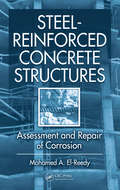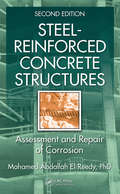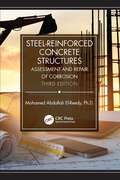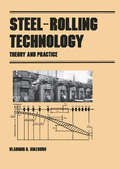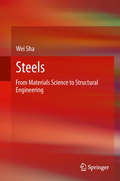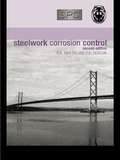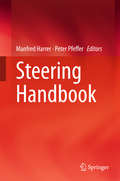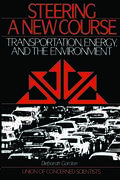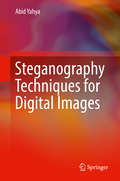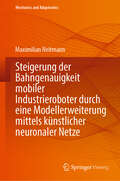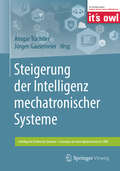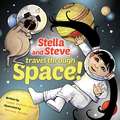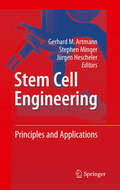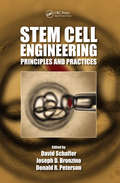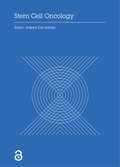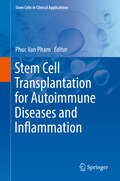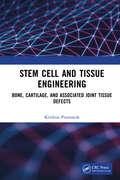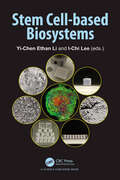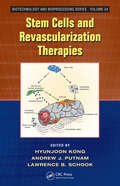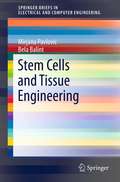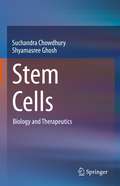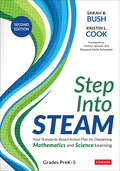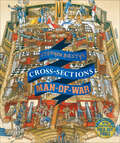- Table View
- List View
Steel-Reinforced Concrete Structures: Assessment and Repair of Corrosion
by Mohamed El-ReedyA Practical Guide to Maintenance Carrying a billion-dollar price tag, corrosion of reinforced concrete is the enemy of every country's investment in real estate. The widespread and long-term use of reinforced concrete makes its correct and proper examination, maintenance, and repair paramount. Steel-Reinforced Concrete Structur
Steel-Reinforced Concrete Structures: Assessment and Repair of Corrosion, Second Edition
by Mohamed El-ReedyThis book examines the corrosion of reinforced concrete from a practical point of view, highlights protective design and repair procedures, and presents ongoing maintenance protocols. Updated throughout, this new edition adds additional information on concrete repair using Carbon Fiber Reinforced Polymers (CFRP), and reviews new examples of the effects of corrosion on both prestressed and reinforced concrete structures. It also examines economic analysis procedures and the probability of structural failures to define structural risk assessment, and covers precautions and recommendations for protecting reinforced concrete structures from corrosion based on the latest codes and specifications.
Steel-Reinforced Concrete Structures: Assessment and Repair of Corrosion, Third Edition
by Mohamed Abdallah El-ReedySteel-Reinforced Concrete Structures: Assessment and Repair of Corrosion, Third Edition examines the corrosion of reinforced concrete from a practical point of view, highlights protective design and repair procedures, and presents ongoing maintenance protocols. Updated throughout, this new edition adds additional information on concrete repair and reviews new examples of the effects of corrosion on both prestressed and reinforced concrete structures. It also examines economic analysis procedures and the probability of structural failures to define structural risk assessment and covers precautions and recommendations for protecting reinforced concrete structures from corrosion based on the latest codes and specifications. Features: Updated throughout and adds all new information on advanced testing and repair techniques Discusses the theoretical and practical methods of performing structural assessments Explains precautions for design and construction that reduce the risk of structural corrosion Covers traditional and advanced techniques for repair and how to choose the best methods Utilizes the newest building codes, specifications, and standards regarding construction and corrosion
Steel-Rolling Technology: Theory and Practice (ISSN)
by Vladimir B. Ginzburg"This state-of-the-art volume examines steel-rolling technology in a systematic and comprehensive manner--providing an excellent synthesis of current information from three different branches of science--physics, metallurgy, and engineering. "
Steels
by Na LiSteels and computer-based modelling are fast growing fields in materials science as well as structural engineering, demonstrated by the large amount of recent literature. Steels: From Materials Science to Structural Engineering combines steels research and model development, including the application of modelling techniques in steels. The latest research includes structural engineering modelling, and novel, prototype alloy steels such as heat-resistant steel, nitride-strengthened ferritic/martensitic steel and low nickel maraging steel. Researchers studying steels will find the topics vital to their work. Materials experts will be able to learn about steels used in structural engineering as well as modelling and apply this increasingly important technique in their steel materials research and development.
Steelwork Corrosion Control
by D.H. Deacon D.A. BaylissEngineers on major building projects continue to echo the sentiment that "painting amounts to 10% of the job, but provides 90% of the problems". This second edition of Steelwork Corrosion Control provides sound advice and authoritative guidance on the principles involved and methods of achieving sound steel protection. Taking into account the consi
Steering Handbook
by Manfred Harrer Peter PfefferThis edited volume presents basic principles as well as advanced concepts of the computational modeling of steering systems. Moreover, the book includes the components and functionalities of modern steering system, which are presented comprehensively and in a practical way. The book is written by more than 15 leading experts from the automotive industry and its components suppliers. The target audience primarily comprises practicing engineers, developers, researchers as well as graduate students who want to specialize in this field.
Steering a New Course: Transportation, Energy, and the Environment
by Warren Leon Deborah GordonSteering a New Course offers a comprehensive survey and analysis of America's transportation system -- how it contributes to our environmental problems and how we could make it safer, more efficient, and less costly.
Steganography Techniques for Digital Images
by Abid YahyaThis book covers newly developed and novel Steganography techniques and algorithms. The book outlines techniques to provide security to a variety of applications using Steganography, with the goal of both hindering an adversary from decoding a hidden message, and also preventing an adversary from suspecting the existence of covert communications. The book looks into applying these newly designed and improved algorithms to provide a new and efficient Steganographic system, called Characteristic Region-Based Image Steganography (CR-BIS). The algorithms combine both the robustness of the Speeded-Up Robust Features technique (SURF) and Discrete Wavelet Transform (DWT) to achieve characteristic region Steganography synchronization. The book also touches on how to avoid hiding data in the whole image by dynamically selecting characteristic regions for the process of embedding. Applies and discusses innovative techniques for hiding text in a digital image file or even using it as a key to the encryption;Provides a variety of methods to achieve characteristic region Steganography synchronization;Shows how Steganography improves upon cryptography by using obscurity features.
Steigerung der Bahngenauigkeit mobiler Industrieroboter durch eine Modellerweiterung mittels künstlicher neuronaler Netze (Mechanics and Adaptronics)
by Maximilian NeitmannMobile Roboter besitzen das Potenzial, zu deutlichen Effizienzsteigerungen in der Fertigung kohlenstofffaserverstärkter Kunststoffe zu führen, wenn sie die aktuell üblichen Sondermaschinen ersetzen. Dazu müssen die mobilen Roboter Bahngenauigkeiten im Submillimeterbereich erreichen. Da stationäre Roboter diese Bahngenauigkeiten mit Modellerweiterungen erreichen können, ist es die Kernfrage dieser Arbeit, ob diese auf mobile Roboter übertragbar sind. Bahngenauigkeitsuntersuchungen zeigen, dass sich die mobile Plattform in erster Linie durch eine herabgesetzte Fundamentsteifigkeit auswirkt. Weiterhin wird beobachtet, dass die Trägheitskräfte des Roboterarmes genügen können, um eine Bewegung der Plattform relativ zum Hallenboden zu erzeugen. Die Arbeit zeigt, dass künstliche neuronale Netze in der Lage sind, den Bahnfehler des mobilen Roboters mit einer mittleren Abweichung zum gemessenen Bahnfehler von 0,3mm vorhersagen zu können und damit potentiell dazu geeignet sind, die Bahngenauigkeit eines mobilen Roboters in den Submillimeterbereich zu steigern. Durch den Austausch des Bahninterpolators zwischen der Aufnahme der Trainingsdaten und der Erprobung der Modellerweiterung kann die Arbeit keine Genauigkeitssteigerungen zeigen. Mit einer Erweiterung des Trainingsdatensatzes oder durch den Einsatz nur eines einzigen Bahninterpolators scheint es jedoch möglich zu sein, dass Folgearbeiten die Steigerung der Bahngenauigkeit in den Submillimeterbereich nachweisen können.
Steigerung der Intelligenz mechatronischer Systeme (Intelligente Technische Systeme – Lösungen aus dem Spitzencluster it’s OWL)
by Ansgar Trächtler Jürgen GausemeierDas Buch beschreibt die Ergebnisse des Querschnittsprojekts „Selbstoptimierung“ des vom BMBF geförderten Spitzencluster-Projekts „Intelligente Technische Systeme OstWestfalenLippe“ (kurz: it’s OWL).Die Entwicklung der Informations- und Kommunikationstechnik eröffnet neue Perspektiven für intelligente technische Systeme, die hohen Kundennutzen stiften. Diese Systeme sind in der Lage, sich ihrer Umgebung und den Wünschen ihrer Anwender im Betrieb anzupassen. Für den Innovationssprung von der Mechatronik hin zu selbstoptimierenden Systemen wird Expertise aus den Gebieten Maschinelles Lernen, mathematische Optimierungsverfahren, Regelungstechnik und Condition Monitoring benötigt.Zielsetzung des Cluster-Querschnittsprojekts Selbstoptimierung war ein Instrumentarium zur Planung und Entwicklung von selbstoptimierenden Produkten und Produktionssystemen. Dieses soll die Entwickler in den Unternehmen bei der Realisierung von Ansätzen der Selbstoptimierung praxisgerecht unterstützen. Das vorliegende Buch stellt das erarbeitete Instrumentarium mit den entsprechenden Schwerpunkten im Detail vor. Dabei werden die wesentlichen Grundlagen der jeweiligen Fachgebiete gezeigt und die methodische Umsetzung anhand von Praxisbeispielen aus dem Spitzencluster erläutert.
Stella and Steve Travel through Space!
by Bethany Straker James Duffett-SmithDid you know that Jupiter is eleven times the size of Earth? The solar system is an incredible place that is still mostly unexplored. So, when Stella and her family move to a new town-where Stella has no friends except for her dog Steve-she goes exploring. In this educational book, travel across the solar system with Stella and Steve as Stella looks for a new home on another planet and imagines what life would be like on another world, from Mercury to Pluto. But along the way Stella learns that Venus has acid rain and Neptune is made entirely of gas, and she begins to wonder whether Earth might actually be the perfect home for her after all.Featuring a fun and informational story from author James Duffett-Smith, and bold, comic book style illustrations by Bethany Straker, Stella and Steve Travel Through Space shows just how great the Earth is (while providing young children with an early science lesson) in a twist on "there's no place like home." A quirky but education book on the solar system (with slight undertones of conserving the Earth), this book for children ages 3 to 6 is sure to find a home in preschool and Kindergarten classrooms as well as home across the globe. Parents will love the science information throughout and kids will instantly connect with Stella and her suave pug Steve. Children will learn the basics about the solar system, the various planets, and why we are able to live on Earth so well.
Stem Cell Engineering
by Jürgen Hescheler Stephen Minger Gerhard M. ArtmannThe potential of stem cells for healing and disease prevention in all fields of medicine is tremendous and has revolutionized the high-tech biomedical research. In this book, many of the most prominent researchers discuss the challenging topics of stem cell engineering, for example: Ethical issues of stem cell research; technological challenges, stem cell growth and differentiation, therapeutic applications, bioreactors and bioprocesses, high throughput and microfluidic screening platforms, stem cell identification and sorting, intercellular signaling and engineered niches, novel approaches for embryonic and adult stem cell growth and differentiation, stem cells and drug discovery, screening platforms. Stem Cell Engineering offers valuable background and reference for both the public and professionals including industrial staffers, faculty, researchers, engineers, students and scientific journalists.
Stem Cell Engineering: Principles and Practices
by Joseph D. Bronzino Donald R. Peterson David SchafferWhile the potential of stem cells is recognized, their proliferation and differentiation must be more precisely controlled to maximize the production of therapeutically relevant cells and for cell replacement therapies to minimize contamination with residual cells that can give rise to side effects. With contributions from pioneers and experts, this book provides a broad overview of the challenges of stem cell engineering. It discusses advances made during the last decade that have led to increasingly defined culture systems for growing human ES cells, starting from co-culture with feeder cells in the presence of serum to growth on synthetic substrates in defined medium. The book highlights recent advances in the understanding of the cellular and molecular composition of the hematopoietic stem cell niche, as well as approaches to build upon this basic information to direct stem cell differentiation into blood cell lineages.
Stem Cell Oncology: Proceedings of the International Stem Cell and Oncology Conference (ISCOC, 2017), December 1-2, 2017, Medan, Indonesia
by Adeya AdellaStem cell research is one of the fascinating areas of contemporary biology, but, as with many expanding fields of scientific inquiry, research on stem cells raises scientific questions as rapidly as it generates discoveries. Research on stem cell treatment continues to advance knowledge about how an organism develops from a single cell and how healthy cells replace damaged cells in adult organisms. The most important potential application of human stem cells is the generation of cells and tissues that could be used for cell-based therapies, especially oncology. The Faculty of Medicine, Universitas Sumatera Utara, collaborated with the center of excellence and innovation (Pusat Unggulan Inovasi /PUI). The Stem Cell center of the Universitas Sumatera Utara (USU) organized an International Conference. The International Stem Cell and Oncology Conference (ISCOC) 2017 was a comprehensive academic conference in the field of stem cell and oncology research and also tropical medicine and related scientific topics. We expect Stem Cell Oncology will benefit academics and practitioners in the field of health sciences in Indonesia. This is an Open Access ebook, and can be found on www.taylorfrancis.com.
Stem Cell Transplantation for Autoimmune Diseases and Inflammation (Stem Cells in Clinical Applications)
by Phuc Van PhamThis book introduces many new technologies and clinical applications of hematopoietic stem cells and mesenchymal stem cell transplantation for the treatment of autoimmune diseases and inflammatory diseases. Presented in two parts, Part 1 focuses on stem cell therapies for autoimmune disease treatment; Part 2 focuses on stem cell therapies and their application in the treatment of common inflammatory diseases, including chronic knee osteoarthritis, chronic obstructive pulmonary disease, liver cirrhosis, Crohn's Disease, Multiple Sclerosis, and more. This book is an essential source for all advanced students and researchers involved with these diseases, stem cells, or both. Stem Cell Transplantation for Autoimmune Diseases and Inflammation and the other books in the Stem Cells in Clinical Applications series are invaluable to scientists, researchers, advanced students and clinicians working in stem cells, regenerative medicine, or tissue engineering as well as cancer or genetics research.
Stem Cell and Tissue Engineering: Bone, Cartilage, and Associated Joint Tissue Defects
by Krishna PramanikThis book covers conventional clinical treatment methods for handling bone, cartilage, and related disorders along with their limitations and highlights the current state of the art of tissue engineering as an alternative for regenerating such defective tissue. Potential biomimetic scaffolding materials and their development, desired properties, modifications, and optimizations are described. The design and advancement in fabrication, characterization, properties, and biological functions of scaffolds, their integration with stem cells, and various bioreactor systems for tissue regeneration are presented. It further reviews in vitro and in vivo (pre-clinical) assessments of tissue constructs, involved translational challenges, and strategies in various stages of neo-tissue production.Features: Discusses the key aspects of generating engineered bone, cartilage, and associated tissues through tissue engineering approach Describes multiple engineering principles, and processes involved in the various stages of developing biomaterials and scaffolds Covers integration of stem cells with scaffolds, including assessment of tissue grafts, and translational strategy Explores key factors influencing tissue graft generation in bioreactors and challenges involved in various stages Includes several exercises including review questions and numerical problems for better understanding of the subject This book is aimed at researchers, students, and professionals in biomedical engineering, tissue engineering, stem cells, biomaterials, and orthopaedics.
Stem Cell-based Biosystems
by Yi-Chen Ethan Li I-Chi LeeStem cell science has emerged as a novel discipline in biomedical research over the past decade. With advancements in this field, stem cells have demonstrated versatile applications ranging from basic research to clinical case studies. Recognizing the demand for knowledge in stem cell applications, this book aims to provide comprehensive information on stem cell technology and its application in biosystems. It covers fundamental culture methods, advanced stem cell-based biosystems, and clinical case studies of stem cell therapy. This book is intended for individuals with an interest in stem cell science, offering valuable insights into this rapidly evolving field.
Stem Cells and Revascularization Therapies
by Lawrence B. Schook Hyunjoon Kong Andrew J. PutnamIn the last few decades, significant advancements in the biology and engineering of stem cells have enabled progress in their clinical application to revascularization therapies. Some strategies involve the mobilization of endogenous stem cell populations, and others employ cell transplantation. However, both techniques have benefited from multidis
Stem Cells and Tissue Engineering
by Bela Balint Mirjana PavlovicStem cells are the building blocks for all other cells in an organism. The human body has about 200 different types of cells and any of those cells can be produced by a stem cell. This fact emphasizes the significance of stem cells in transplantational medicine, regenerative therapy and bioengineering. Whether embryonic or adult, these cells can be used for the successful treatment of a wide range of diseases that were not treatable before, such as osteogenesis imperfecta in children, different forms of leukemias, acute myocardial infarction, some neural damages and diseases, etc. Bioengineering, e.g. successful manipulation of these cells with multipotential capacity of differentiation toward appropriate patterns and precise quantity, are the prerequisites for successful outcome and treatment. By combining in vivo and in vitro techniques, it is now possible to manage the wide spectrum of tissue damages and organ diseases. Although the stem-cell therapy is not a response to all the questions, it provides more and more answers every day. Stem Cells and Tissue Engineering is a concise review on the functional, phenotypic, regenerative, transplantational and curative aspects of a stem cell's entity. It is critical and encouraging at the same time, providing truthful and appropriate samples from the practice and research that can lead toward optimal use of this immense source of adjuvant and curative therapy in human pathology. Written by a clinician and a researcher, who are currently teaching what they are doing, it is recommended as a teaching tool along with an original textbook.
Stem Cells: Biology and Therapeutics
by Shyamasree Ghosh Suchandra ChowdhuryStem cells hold great promise for cell therapy, tissue engineering, regenerative medicine and pharmaceutical and biotechnological applications. This book highlights the potency of stem cells, their property of self-renewal and their ability to differentiate into different cell lineages. It further describes the different markers to identify stem cells, sources, methods of isolation, culture including 2D, 3D and beyond and their cryopreservation. This is among the first books to discuss glycosylation and sialylation in stem cells. Chapters describe application of stem cells in regenerative medicine and therapy, and highlight their application in cancer therapy and spinal cord injury. The book talks about the important patents on stem cells. The book also highlights the plant stem cells, discussing their pluoripotent nature, role in organ regeneration after injury, specific stem cell niches, that signals to block differentiation studied in plants shoot, root, and vascular meristems, differentiation of plant stem cell, transcriptional regulation and epigenetic modification of plant stem cells. This book is exciting and cutting edge. It will be of great interest to doctors, students and researchers in the field of regenerative medicine, cancer , biotechnology and plant sciences.
Step Into STEAM, Grades PreK-5: Your Standards-Based Action Plan for Deepening Mathematics and Science Learning
by Sarah B. Bush Kristin L. CookCreate innovative and equitable experiences that prepare your learners for the future! STEAM education is crucial for preparing learners to meet the demands of a rapidly evolving world. Not every learner is going to pursue a STEAM-related career, but each and every learner needs to be challenged with opportunities to transfer what they are learning in mathematics and science instruction to seek solutions to the complex problems of today—and to meet our future world head on! In this Second Edition of Step Into STEAM, authors Sarah Bush and Kristin Cook guide and inspire PreK–5 educators through a seamless process of designing and implementing STEAM inquiries that align precisely to key mathematics and science content and practices—all while meeting the demands of guiding assessments. Going far beyond a collection of STEAM activities, this book shows educators, as well as school and district leaders, how to build a STEAM ecosystem that can measurably improve every learner’s mathematics and science achievement, as well as engagement, belonging, and interest. What truly sets this book apart is its masterful integration of problem-based inquiry as the foundation for STEAM instruction. This updated edition: Expands on the latest research in STEAM education across PreK-5 in various educational settings Incorporates strategies grounded in Universal Design for Learning to engage all learners Provides updated STEAM resources aligned to the Integrated STEM Practices Embeds actionable tips throughout each chapter that educators can implement immediately in addition to suggestions for ongoing learning and growth for all Offers an updated companion website with additional templates for brainstorming sessions or book studies, action plans, and checklists to help educators put their ideas into practice This is an essential guide for educators looking to implement STEAM education in their classrooms and beyond. Step Into STEAM provides a comprehensive roadmap for cultivating the creativity, problem-solving abilities, resilience, and empathy that will empower the next generation of innovators, entrepreneurs, and global citizens. Make the most of your limited instructional time and become part of the Step Into STEAM journey!
Step Into STEAM, Grades PreK-5: Your Standards-Based Action Plan for Deepening Mathematics and Science Learning
by Sarah B. Bush Kristin L. CookCreate innovative and equitable experiences that prepare your learners for the future! STEAM education is crucial for preparing learners to meet the demands of a rapidly evolving world. Not every learner is going to pursue a STEAM-related career, but each and every learner needs to be challenged with opportunities to transfer what they are learning in mathematics and science instruction to seek solutions to the complex problems of today—and to meet our future world head on! In this Second Edition of Step Into STEAM, authors Sarah Bush and Kristin Cook guide and inspire PreK–5 educators through a seamless process of designing and implementing STEAM inquiries that align precisely to key mathematics and science content and practices—all while meeting the demands of guiding assessments. Going far beyond a collection of STEAM activities, this book shows educators, as well as school and district leaders, how to build a STEAM ecosystem that can measurably improve every learner’s mathematics and science achievement, as well as engagement, belonging, and interest. What truly sets this book apart is its masterful integration of problem-based inquiry as the foundation for STEAM instruction. This updated edition: Expands on the latest research in STEAM education across PreK-5 in various educational settings Incorporates strategies grounded in Universal Design for Learning to engage all learners Provides updated STEAM resources aligned to the Integrated STEM Practices Embeds actionable tips throughout each chapter that educators can implement immediately in addition to suggestions for ongoing learning and growth for all Offers an updated companion website with additional templates for brainstorming sessions or book studies, action plans, and checklists to help educators put their ideas into practice This is an essential guide for educators looking to implement STEAM education in their classrooms and beyond. Step Into STEAM provides a comprehensive roadmap for cultivating the creativity, problem-solving abilities, resilience, and empathy that will empower the next generation of innovators, entrepreneurs, and global citizens. Make the most of your limited instructional time and become part of the Step Into STEAM journey!
Step-by-Step QFD: Customer-Driven Product Design, Second Edition
by John TerninkoWouldn't it be great if you could design a product with the customer in mind - right from the very start? Well, now there's a way: Quality Function Development, or QFD, translates the needs of the consumer directly into the design and development of new products and services. By focusing on customer needs and incorporating them into every phase of the manufacturing process, it eliminates waste and improves customer satisfaction. And that means increased sales, greater profits, and a bigger share of the market.Step-by-Step QFD is a practical, hands-on guide to implementing QFD at any organization. Written by an expert in the field, it shoes how the intensive study of consumer needs can be used to help you dramatically outperform the competition. In fact, the strategies outlined in this book have already met with great success at a number of corporations both within and outside of the United States. This workbook includes a case study of QFD in action, 34 helpful workshops, and an analysis of the synergy between QFD, TRIZ, and Taguchi. So whether you're a QFD trainer, project manager, design engineer, or manufacturer, Step-by-Step QFD will show you how to let one voice drive your entire design process - the customer's!
Stephen Biesty's Cross-Sections Man-of-War (DK Stephen Biesty Cross-Sections)
by Richard PlattLook inside an 18th-century warship as it sails into battle on the high seas.Packed with extraordinary illustrations, this history book for children covers everything from warship design to navigation. Biesty's incredible drawings slice through a man-of-war to explore every corner, from the crow's nest to the stinking hold. Packed with fascinating facts and gory details, the pages teem with sailors going about their duties. Find out how gun crews fired a cannon, examine a surgeon's toolkit, and learn the best way to wriggle the maggots out of the ship's biscuits. Look out, too, for the stowaway on every page. He's the one with spiky hair, and there's a reward for his capture!This absorbing book will have children--and adults--poring over every page. Celebrating its 25th anniversary, Stephen Biesty's Cross-Sections Man-of-War remains as entertaining as ever.
